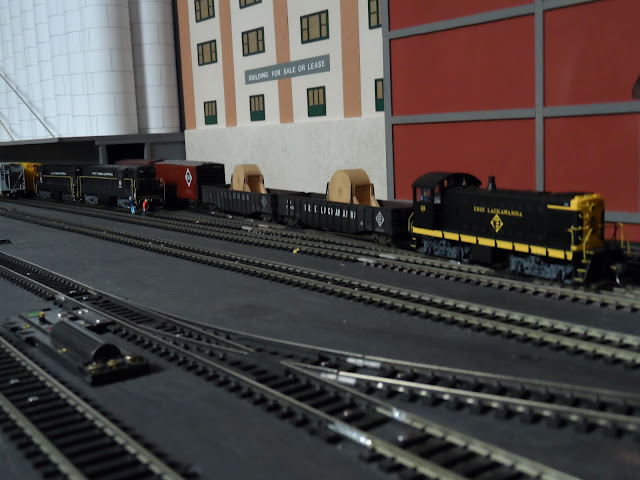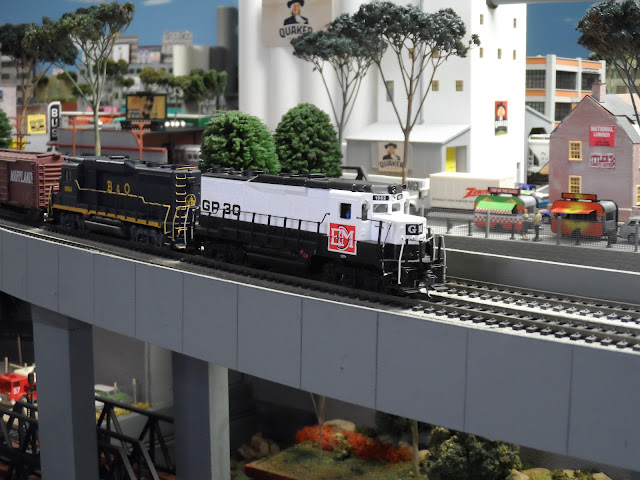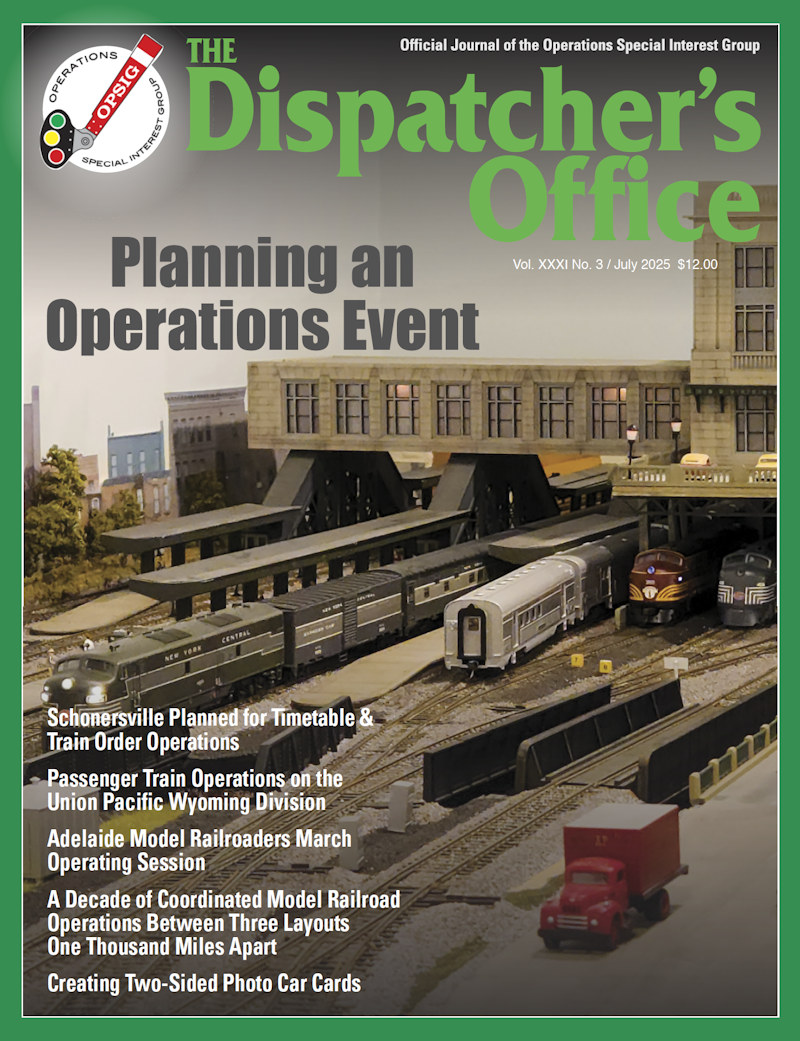Greetings All,
2025 The Year in Review
It's that time of year again to look back at what took place on the layout, with the rolling stock and the motive power. Here is a recap of 2025 projects, additions and other model railroading doings.
Big Doings in January
The year started with major layout adjustments that had me closing down the Cargill Grain elevator in Empire City, moving Ralph's Grocery Warehouse and adding the Quaker Oats Plant in their place.
The Quaker Oats Plant rises above Empire City and is ready to open adding interesting freight cars and movements to support the plant.
Ralph's Grocery Warehouse gets moved to the new Bedford Overbuild with an increased freight car siding below the overbuild that can now handle five 50' boxcars. An increase from three freight cars at the old address in Empire City.
Ralph's Grocery Warehouse gets moved to the new Bedford Overbuild with an increased freight car siding below the overbuild that can now handle five 50' boxcars. An increase from three freight cars at the old address in Empire City.
February 2025
February featured some more research into better layout freight traffic operations and Penn Central Car Movements #109.
Below the Bedford Turn has swelled in size since Ralph's Grocery Warehouse moved to Bedford.
March, 2025
A pair of Athearn DCC / Sound Ready New Haven RS3s joined the fleet and were highlighted in Locomotive Spotlight #1-2025.
The Purgatory Box provided several non powered locomotives that had been powered and stored repairs deferred. UP 721 and NYC 2194 number two and three in the consist are such a pair.
We closed out PCCM 110 in early April in Part 7 with the B&O doing some of the honors.
Efficient car movements via caboose protected shove moves for Train BP-41 that serves Bedford Park industries like the Ford Plant were tested and put in place. Below, the 7608 is shoving the BP-41 out of Terminal Yard.
This turned out to be a busy month for operations and the purchasing department. Below preordered Atlas Classic Penn Central RS11s arrived on the layout.
The Lehigh Valley and Erie Lackawanna joined in the operations sending transfers from their respective New York City waterfront yards to and from Terminal Yard via the 12th Ave running track under the grain silos.
The Purchasing Department procured five mechanical refrigerators to bolster the temperature controlled fleet.
The people of Empire City will be enjoying West Coast Produce!
Also included this month was participation in Penn Central Car Movements #111. Below B&O H16-44s working out of their 16th Street Yard handled interchange traffic between and B&O and PC.
Also included this month was participation in Penn Central Car Movements #111. Below B&O H16-44s working out of their 16th Street Yard handled interchange traffic between and B&O and PC.
We continued and concluded our PCCM 111 operations in early June. Below the new Atlas PC RS11s make their PCCM debut.
A Bachmann Spectrum GP30 Demonstrator arose from the dead line with a new power chassis to become one of the best running GP30s in the combined family fleet.
A used New Haven Fairbanks-Morse CP24-5 #791 shell found its way onto a spare FM C-Liner power chassis and was put into service.And if that wasn't enough for one month more New Haven power and rolling stock arrived on the layout.
The first of the AP500 boxcars were released from the Patti-O Paint Shop as part of a joint APRR-NYCTL project.
This was followed by a two part look at the New Haven Railroad and the Class of '56 motive power series.
Penn Central Car Movements #112 closed out the month. Below PC Train MR-1 (Mine Run) departs Terminal Yard behind a pair of GP7s.
A Penn Central Car Movements article called Ten Years Of Coordinated Operations by Three Layouts One Thousand Miles Apart by Neal, Ralph and I was published in the Operations Special Interest Group's July, 2025 Dispatcher's Office.
August, 2025
In early August we closed out the PCCM 112 series. Below the Empire Belt RR is ready to deliver inbound freight cars to local consignees.
A pair of junk Osgood Bradley New Haven passenger car coaches were resurrected from the scrap heap and put into revenue service.
Two distinctive Cargill Salt covered hoppers were added to the roster to service Quaker Oats, other food processing factories and NYS DOT #10 with road salt.
September, 2025
A pre-ordered Scale Trains DCC Sound Equipped Norfolk Southern GE AC44C6M #4082 arrived on the layout and was covered in Locomotive Spotlight #5-2025.This was followed by some temporary Intermodal Insanity that needed an intervention from 1:87 Scale Sir Neal.
This was only part of the haul!!
1:87 scale Sir Neal attempts an intervention.Later in the month I enjoyed some off layout railfanning along the Rhine River and in several other cities.
October, 2025
The gang was back together for PCCM 113. Below a pair of LIRR Alcos kick off the Outbound portion of the three layout virtual op.
Six treated railroad tie loads were built for my PCCM and non PCCM gondolas.
This was followed by six untreated railroad ties built underneath the treated ties as suggested by PC Ralph who followed with five similar RR tie loads for his PCCM gondolas.
Lastly wrapped wood loads were purchased for several bulkhead flatcars thanks to the tenacity of 1:1 Sir Neal who tracked them down for a great price from an unlikely source.
Lastly wrapped wood loads were purchased for several bulkhead flatcars thanks to the tenacity of 1:1 Sir Neal who tracked them down for a great price from an unlikely source.
November, 2025
An HO Scale Kato Japanese DD51 diesel hydraulic was purchased from their factory for me by my neighbor and friend who vacationed in Japan with his family.
We honored the United States Marines celebrating their 250th birthday on November 10th and our United States Veterans on November, 11th.
The gang participated in a special PCCM #114 nicknamed "Operation Blue Comet" in support of 1:1 fellow modeler Steve Neubaum and his generous public service activities providing model railroad display layouts in the Hartford, WI area.
The gang participated in a special PCCM #114 nicknamed "Operation Blue Comet" in support of 1:1 fellow modeler Steve Neubaum and his generous public service activities providing model railroad display layouts in the Hartford, WI area.
Neubaum's Coffee & Tea Importers served as the Blue Comet Presentations HQ in Bedford, NY. The op featured lots of LCL traffic moving across our layouts for the first time.
B&O S12 #9278 was a big winner getting a new gold flywheel power chassis and a complete set of handrails from the undecorated BB S12 that was part of the above haul.
December, 2025
Three ATSF Mechanical Temperature Cars and a BN RBL were added to the growing reefer fleet.
Research into the prototypical operations of these and the other reefers in my fleet pointed out the need not only for refrigeration but for protective heater service usually between October and March in northern climates.
Below two of the ATSF MTC cars will provide protective heater service for the lading of 55 gallon drums of water based ink from Drywell Inks
Two Penn Central and one New York Central 50' reefers received some cosmetic changes with the patch out of their reporting marks and numbers to Empire Belt EBRR reporting marks and numbers.
Because I didn't have enough reefers on the layout this new SFRB 6497 RBL joined the burgeoning fleet in early December.
The 6497 features the well known "Ship and Travel Santa Fe" logo on one side (above) and the "Route of El Capitan" on the other side.Last but not least Train #29, "The Savoy" made it's debut in the "Tales from the Coach Yard" post that examined some newly added passenger cars and cars in the existing fleet.
A Budd 24-8 sleeper car #10800 is one of four leased from Budd by the NYC (10800-10803) in 1959.
Baggage Lounge Car #34 brings up the rear of the west bound Savoy.Numerous videos were uploaded to the channel which culminated in a twenty five part Holiday Hotshots series. To see the entire series playlist click on the below link.
Looking Forward to 2026
As of this writing there are two Locomotive Spotlights in the works, another joint APRR-NYCTL paint project nearing completion and we'll take a look at what train related items arrived under the Christmas tree. Penn Central Car Movements will also resume in the new year with a planning session set for early January.
Wishing Everyone a Happy & Healthy New Year!!!
See you soon!!!




















































